Reconceptualising Children, Childhood, and Identity
VerifiedAdded on 2023/06/12
|14
|3689
|485
AI Summary
This article explores the impact of social environment and relationships on children's development and citizenship. It covers topics such as gender identity, ethnicity, class identity, religion, physical environment, and children's voice and participation. It also discusses children's agency, curriculum, and pedagogy.
Contribute Materials
Your contribution can guide someone’s learning journey. Share your
documents today.
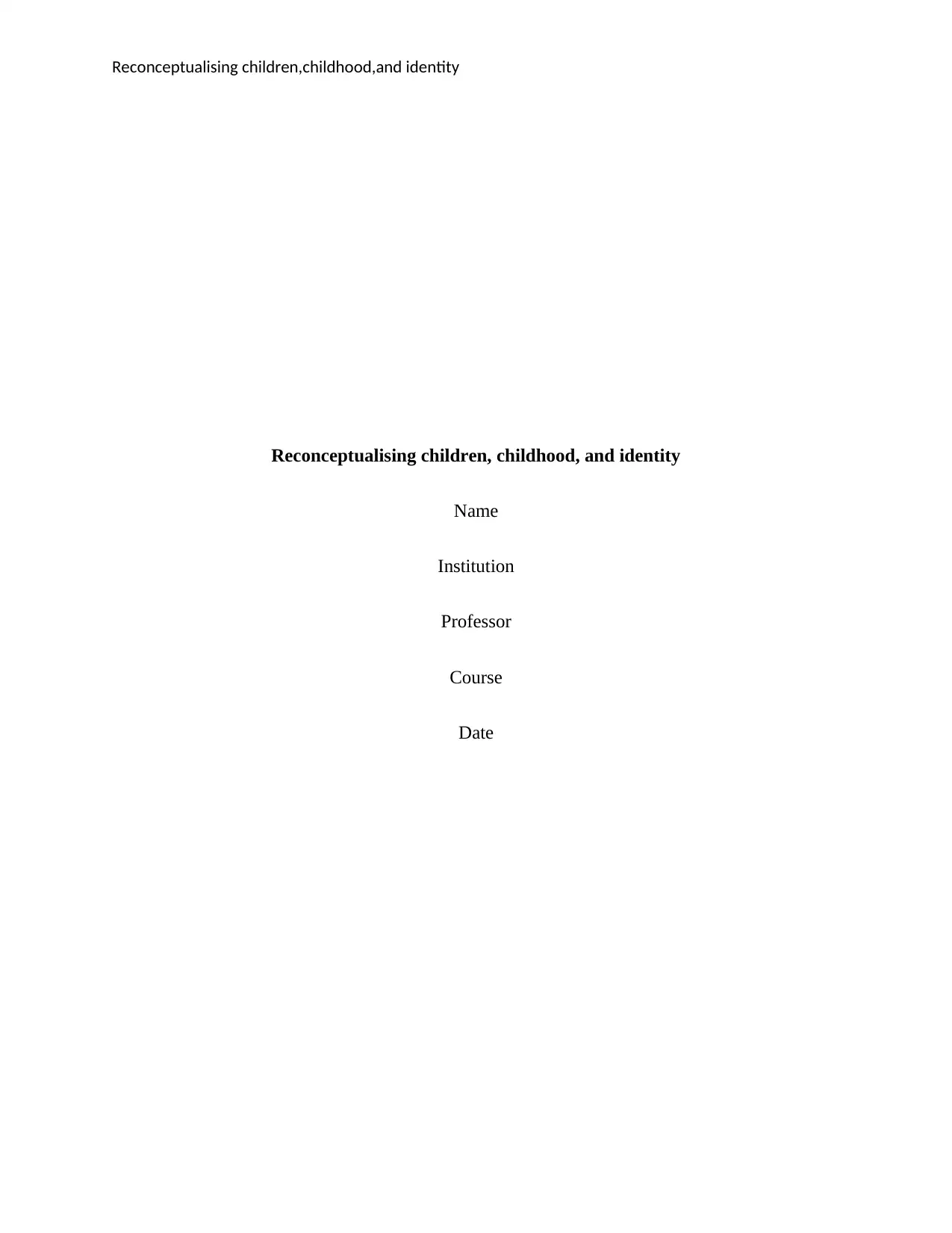
Reconceptualising children,childhood,and identity
Reconceptualising children, childhood, and identity
Name
Institution
Professor
Course
Date
Reconceptualising children, childhood, and identity
Name
Institution
Professor
Course
Date
Secure Best Marks with AI Grader
Need help grading? Try our AI Grader for instant feedback on your assignments.
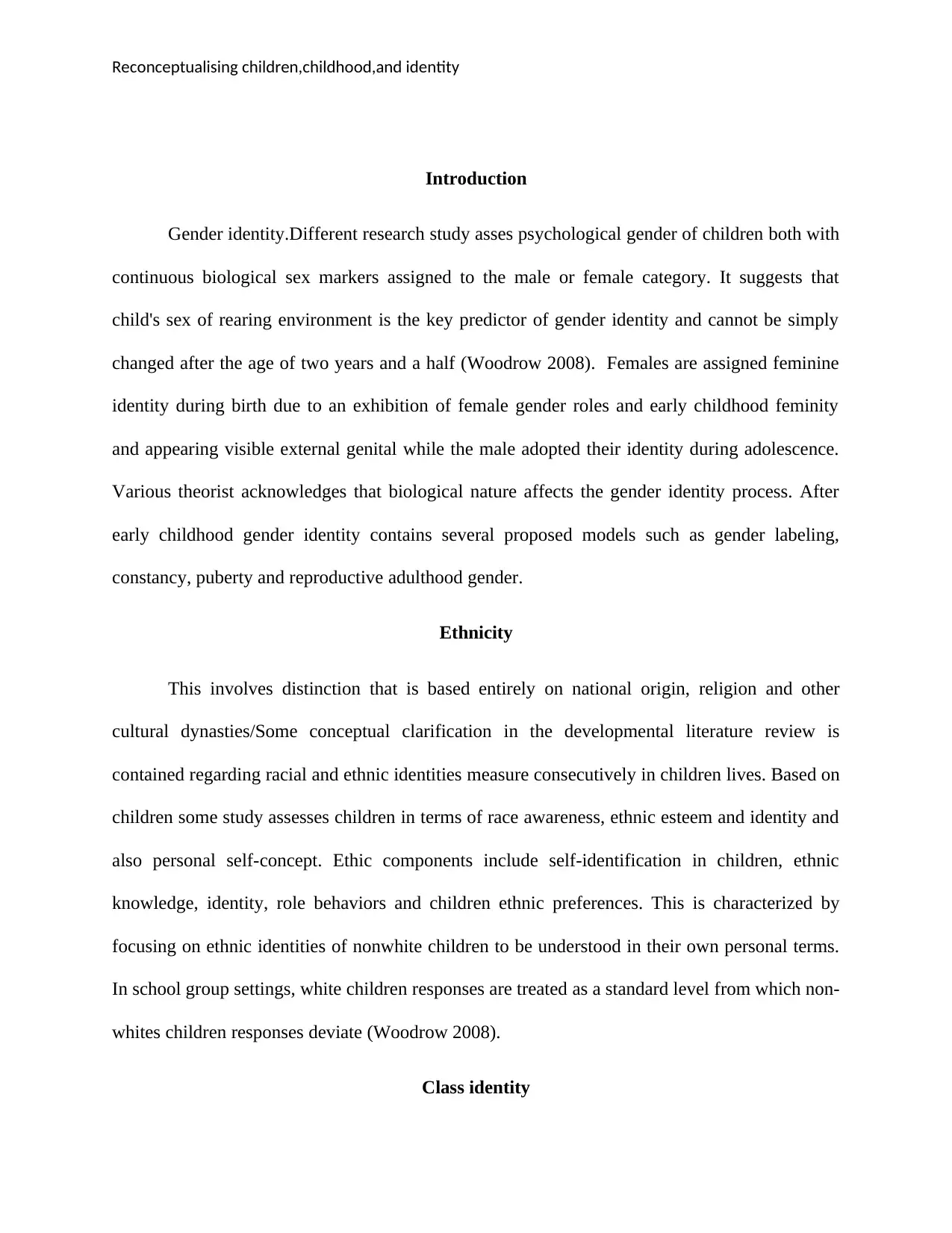
Reconceptualising children,childhood,and identity
Introduction
Gender identity.Different research study asses psychological gender of children both with
continuous biological sex markers assigned to the male or female category. It suggests that
child's sex of rearing environment is the key predictor of gender identity and cannot be simply
changed after the age of two years and a half (Woodrow 2008). Females are assigned feminine
identity during birth due to an exhibition of female gender roles and early childhood feminity
and appearing visible external genital while the male adopted their identity during adolescence.
Various theorist acknowledges that biological nature affects the gender identity process. After
early childhood gender identity contains several proposed models such as gender labeling,
constancy, puberty and reproductive adulthood gender.
Ethnicity
This involves distinction that is based entirely on national origin, religion and other
cultural dynasties/Some conceptual clarification in the developmental literature review is
contained regarding racial and ethnic identities measure consecutively in children lives. Based on
children some study assesses children in terms of race awareness, ethnic esteem and identity and
also personal self-concept. Ethic components include self-identification in children, ethnic
knowledge, identity, role behaviors and children ethnic preferences. This is characterized by
focusing on ethnic identities of nonwhite children to be understood in their own personal terms.
In school group settings, white children responses are treated as a standard level from which non-
whites children responses deviate (Woodrow 2008).
Class identity
Introduction
Gender identity.Different research study asses psychological gender of children both with
continuous biological sex markers assigned to the male or female category. It suggests that
child's sex of rearing environment is the key predictor of gender identity and cannot be simply
changed after the age of two years and a half (Woodrow 2008). Females are assigned feminine
identity during birth due to an exhibition of female gender roles and early childhood feminity
and appearing visible external genital while the male adopted their identity during adolescence.
Various theorist acknowledges that biological nature affects the gender identity process. After
early childhood gender identity contains several proposed models such as gender labeling,
constancy, puberty and reproductive adulthood gender.
Ethnicity
This involves distinction that is based entirely on national origin, religion and other
cultural dynasties/Some conceptual clarification in the developmental literature review is
contained regarding racial and ethnic identities measure consecutively in children lives. Based on
children some study assesses children in terms of race awareness, ethnic esteem and identity and
also personal self-concept. Ethic components include self-identification in children, ethnic
knowledge, identity, role behaviors and children ethnic preferences. This is characterized by
focusing on ethnic identities of nonwhite children to be understood in their own personal terms.
In school group settings, white children responses are treated as a standard level from which non-
whites children responses deviate (Woodrow 2008).
Class identity
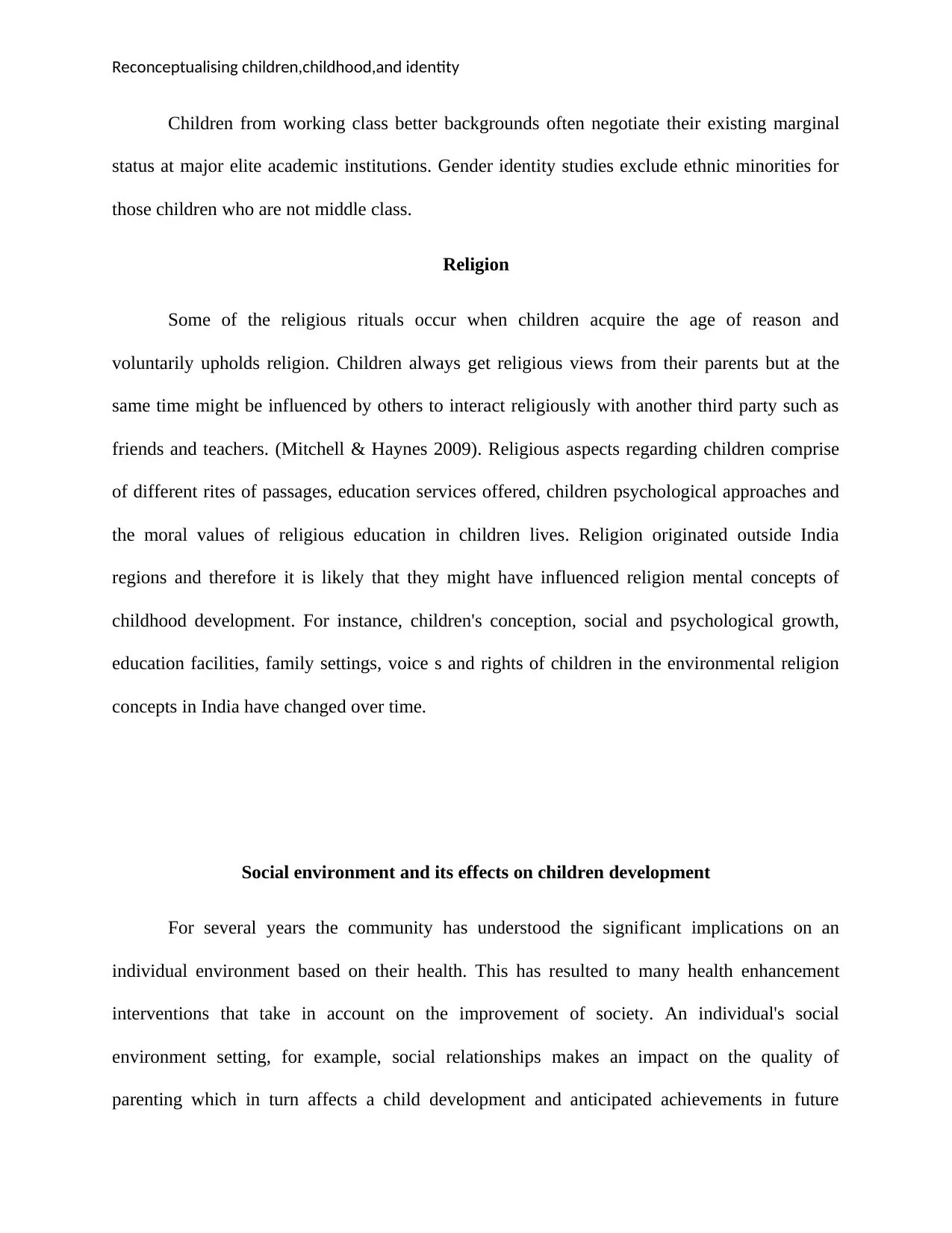
Reconceptualising children,childhood,and identity
Children from working class better backgrounds often negotiate their existing marginal
status at major elite academic institutions. Gender identity studies exclude ethnic minorities for
those children who are not middle class.
Religion
Some of the religious rituals occur when children acquire the age of reason and
voluntarily upholds religion. Children always get religious views from their parents but at the
same time might be influenced by others to interact religiously with another third party such as
friends and teachers. (Mitchell & Haynes 2009). Religious aspects regarding children comprise
of different rites of passages, education services offered, children psychological approaches and
the moral values of religious education in children lives. Religion originated outside India
regions and therefore it is likely that they might have influenced religion mental concepts of
childhood development. For instance, children's conception, social and psychological growth,
education facilities, family settings, voice s and rights of children in the environmental religion
concepts in India have changed over time.
Social environment and its effects on children development
For several years the community has understood the significant implications on an
individual environment based on their health. This has resulted to many health enhancement
interventions that take in account on the improvement of society. An individual's social
environment setting, for example, social relationships makes an impact on the quality of
parenting which in turn affects a child development and anticipated achievements in future
Children from working class better backgrounds often negotiate their existing marginal
status at major elite academic institutions. Gender identity studies exclude ethnic minorities for
those children who are not middle class.
Religion
Some of the religious rituals occur when children acquire the age of reason and
voluntarily upholds religion. Children always get religious views from their parents but at the
same time might be influenced by others to interact religiously with another third party such as
friends and teachers. (Mitchell & Haynes 2009). Religious aspects regarding children comprise
of different rites of passages, education services offered, children psychological approaches and
the moral values of religious education in children lives. Religion originated outside India
regions and therefore it is likely that they might have influenced religion mental concepts of
childhood development. For instance, children's conception, social and psychological growth,
education facilities, family settings, voice s and rights of children in the environmental religion
concepts in India have changed over time.
Social environment and its effects on children development
For several years the community has understood the significant implications on an
individual environment based on their health. This has resulted to many health enhancement
interventions that take in account on the improvement of society. An individual's social
environment setting, for example, social relationships makes an impact on the quality of
parenting which in turn affects a child development and anticipated achievements in future

Reconceptualising children,childhood,and identity
(Larsen et al 2009). Various inclusive social environments offer support to parents in order to
provide parents capacity to care for the children thus contributing to the promotion of better
children development. They also have a positive effect on family system setting who are well-
interconnected offering supportive measures to ensure children's development.
Social environments involve a person's physical surrounding. available societal resources and
social relationships.
Physical environment
The physical environment includes housing, healthcare, education facilities and
recreation centers. Its surrounding nature includes the available open space and quality of
buildings that affect the quality of parenting thus influencing the wellbeing of children in such an
environment.
The significance of social environment
A child's environment is massively determined by the places their parents reside and take
them study in educational institutions (Van Cauwenberg 2011). In this case,it indicates who
children make close relationships with the quality of highsocialnessof children that are within the
family backround. Therefore, the parent's decisions about where to live, workplaces, education
institutions can influence the health and children development
Physical surroundings
A person's physical surroundings usually influence their health conditions.For instance,
environments made up of spacious and decent housing have low poverty and high stability in
residential areas (Woodrow 2008). These affect a child's social relationship and healthy
(Larsen et al 2009). Various inclusive social environments offer support to parents in order to
provide parents capacity to care for the children thus contributing to the promotion of better
children development. They also have a positive effect on family system setting who are well-
interconnected offering supportive measures to ensure children's development.
Social environments involve a person's physical surrounding. available societal resources and
social relationships.
Physical environment
The physical environment includes housing, healthcare, education facilities and
recreation centers. Its surrounding nature includes the available open space and quality of
buildings that affect the quality of parenting thus influencing the wellbeing of children in such an
environment.
The significance of social environment
A child's environment is massively determined by the places their parents reside and take
them study in educational institutions (Van Cauwenberg 2011). In this case,it indicates who
children make close relationships with the quality of highsocialnessof children that are within the
family backround. Therefore, the parent's decisions about where to live, workplaces, education
institutions can influence the health and children development
Physical surroundings
A person's physical surroundings usually influence their health conditions.For instance,
environments made up of spacious and decent housing have low poverty and high stability in
residential areas (Woodrow 2008). These affect a child's social relationship and healthy
Secure Best Marks with AI Grader
Need help grading? Try our AI Grader for instant feedback on your assignments.

Reconceptualising children,childhood,and identity
development. Children who change residential areas rapidly since their parents have no choice
but to find an affordable neighborhood view it to be problematic to develop a clear social setting
and might make them underperform at a school level. Indian children who lived in cleaner
residential areas were assessed to acquire advanced social behaviors as compared to those
children living in less clean environments.
The availability of better quality education systems and facilities within a particular
environment is very significant, for instance, attendance of early childhood education is often
associated with increased childhood growth and development as people residing in social-
economically marginalized areas have minimal access to early childhood education facilities and
are less likely to enjoy its anticipated benefits. The availability of employment opportunities
within the community also has several implications for child's development by the influence on
their parent's work level and workplace. Those who carry out their work activities consume less
travel time spending more time with their families as it also involves less work stressful
conditions (Van Cauwenberg et al 2011). Stress on work and various time constraints have
negative effects on individuals and affects family relationships including parent-child links.
Working in the local areas usually improve on parenting strategies especially on the ultimate
relationships between child and parents leading to increased health standards and better children
growth and development. Research indicates that in India, abundant housing and job
opportunities in areas affects the levels of child harassment as they are less likely to be
mistreated in a societal with a readily available decent housing.
Adults role
Community resources
development. Children who change residential areas rapidly since their parents have no choice
but to find an affordable neighborhood view it to be problematic to develop a clear social setting
and might make them underperform at a school level. Indian children who lived in cleaner
residential areas were assessed to acquire advanced social behaviors as compared to those
children living in less clean environments.
The availability of better quality education systems and facilities within a particular
environment is very significant, for instance, attendance of early childhood education is often
associated with increased childhood growth and development as people residing in social-
economically marginalized areas have minimal access to early childhood education facilities and
are less likely to enjoy its anticipated benefits. The availability of employment opportunities
within the community also has several implications for child's development by the influence on
their parent's work level and workplace. Those who carry out their work activities consume less
travel time spending more time with their families as it also involves less work stressful
conditions (Van Cauwenberg et al 2011). Stress on work and various time constraints have
negative effects on individuals and affects family relationships including parent-child links.
Working in the local areas usually improve on parenting strategies especially on the ultimate
relationships between child and parents leading to increased health standards and better children
growth and development. Research indicates that in India, abundant housing and job
opportunities in areas affects the levels of child harassment as they are less likely to be
mistreated in a societal with a readily available decent housing.
Adults role
Community resources

Reconceptualising children,childhood,and identity
Adults including parents play a major role in taking their children to school in order to acquire
education services by instilling knowledge and skills important in shaping their successful future
endeavors. Typically, they rely on available resources for example teachers and other existing
adults e.g. family members and friends in facilitating their parenting role to the maximum levels.
The degree of national cohesion among society members affects the nature of parent to child
relationships.Children should learn the art of team play involvement and develop their
knowledge in matters pertaining relationships and personal behavior growth (Van Cauwenberg et
al 2011). An Indian study of children indicates that children residing in 257 areas acquire
positive social relationships and are often associated with key prosocial behaviors on children.
An American research shows that children who grow up in more developed neighborhood
experience less negative relationships than those living without such conditions. The rules,
values, and norms that govern an entire society can influence such situations. Many Indian
communities have enacted rules and policies that prevent adults from smoking in children
recreational centers.
Social relationships
Normally,this provide a conducive opportunity for the generation of emerging ideologies,
discussion of concerns and issues affecting children, and offering emotional support (Mitchell &
Haynes 2009). Living in a better social environment promotes the development of child's identity
and behaviors as children learn from their social environment. Parent s and teachers in classroom
setting reinforce good behaviors and impart social skills by actively teaching the children and
encouraging them regularly.
How do social environments and social relationships affect children?
Adults including parents play a major role in taking their children to school in order to acquire
education services by instilling knowledge and skills important in shaping their successful future
endeavors. Typically, they rely on available resources for example teachers and other existing
adults e.g. family members and friends in facilitating their parenting role to the maximum levels.
The degree of national cohesion among society members affects the nature of parent to child
relationships.Children should learn the art of team play involvement and develop their
knowledge in matters pertaining relationships and personal behavior growth (Van Cauwenberg et
al 2011). An Indian study of children indicates that children residing in 257 areas acquire
positive social relationships and are often associated with key prosocial behaviors on children.
An American research shows that children who grow up in more developed neighborhood
experience less negative relationships than those living without such conditions. The rules,
values, and norms that govern an entire society can influence such situations. Many Indian
communities have enacted rules and policies that prevent adults from smoking in children
recreational centers.
Social relationships
Normally,this provide a conducive opportunity for the generation of emerging ideologies,
discussion of concerns and issues affecting children, and offering emotional support (Mitchell &
Haynes 2009). Living in a better social environment promotes the development of child's identity
and behaviors as children learn from their social environment. Parent s and teachers in classroom
setting reinforce good behaviors and impart social skills by actively teaching the children and
encouraging them regularly.
How do social environments and social relationships affect children?

Reconceptualising children,childhood,and identity
Physical environment for children
Every parent needs their children to have every benefit while growing up. In this case,
physical environment for children involves physical components in which children grow, enjoy,
play and participates in different activities. It can be just virtually concrete where youngsters
encounter their day to day lives. Even though it involves its physical settings it at the same time
influences their mental-emotional experiences and overall physical upbringing. This is quite
different from the emotional and learning surroundings that children are upheld in.
Characteristic
Physical safety is very crucial in order to children to grow to adulthood thus the physical
environment must not have any hazards that are entirely harmful to the youngsters' lives. This
could be in the form of electrical appliances, chemical forms and choking on smoke which is
dangerous for their health.
Nutrition is also very significant in the growth and development of their bodies and minds. They
should get healthy food earlier in life that makes them develop better eating habits during future
periods as adults
Children citizenship
Section 4 of the 1955 Indian citizenship act explains the conditions for citizenship by use
of decent means. According to this amended section, a child born outside the country of India
after the Indian national constitution came into account will be a citizen by decent provided only
that the father of the child is a full citizen of India during the time of the youngster's birth.
Physical environment for children
Every parent needs their children to have every benefit while growing up. In this case,
physical environment for children involves physical components in which children grow, enjoy,
play and participates in different activities. It can be just virtually concrete where youngsters
encounter their day to day lives. Even though it involves its physical settings it at the same time
influences their mental-emotional experiences and overall physical upbringing. This is quite
different from the emotional and learning surroundings that children are upheld in.
Characteristic
Physical safety is very crucial in order to children to grow to adulthood thus the physical
environment must not have any hazards that are entirely harmful to the youngsters' lives. This
could be in the form of electrical appliances, chemical forms and choking on smoke which is
dangerous for their health.
Nutrition is also very significant in the growth and development of their bodies and minds. They
should get healthy food earlier in life that makes them develop better eating habits during future
periods as adults
Children citizenship
Section 4 of the 1955 Indian citizenship act explains the conditions for citizenship by use
of decent means. According to this amended section, a child born outside the country of India
after the Indian national constitution came into account will be a citizen by decent provided only
that the father of the child is a full citizen of India during the time of the youngster's birth.
Paraphrase This Document
Need a fresh take? Get an instant paraphrase of this document with our AI Paraphraser

Reconceptualising children,childhood,and identity
However, if the father of the individual a citizen by descent only, the child born shall not be an
Indian citizen by virtue. according to 1992 BBC summary research report, the Indian parliament
adopted an amendment that depicts that a child born outside Indian can only be a citizen if and
only if the father was of Indian citizenship. (Woodrow 2008). Regarding the official
commission, a child born outside Indian country to one parent would also be entitled to acquire
the citizenship of India. Parents ought to provide medical certificate providing all their names
from the hospital where the child was born and also obtain a passport for the child. There's is no
limit of the time frame that child may remain in a neighboring country and still retain their
Indian citizenship.
Children development theories comprise the key constructs that generally inform policy
and curriculum development in initial school years. They are primarily derived from various
scientific models and methods in psychology and biology. These theories have been
continuously utilized by curriculum developers assuming that they offer informed guidance on
the expectations anticipated on children at distinct stages of their early lives. This indicates the
deficiency model where children are seen as fragmented individuals who have not realized or
arrived at their full potential. Over-reliance on scientific paradigm has made theoretical and
methodological theories to be developed especially in a class setting (Van Cauwenberg et al
2011 These paradigms act as the only truth regarding childhood. Policies and curriculum are
composed of language that gradually determines the lives of children. The scientific theories
shaping the 19th century painting an image of the average child constructed from the
predetermined truth especially in the western world leaves no allowance for cultural class and
However, if the father of the individual a citizen by descent only, the child born shall not be an
Indian citizen by virtue. according to 1992 BBC summary research report, the Indian parliament
adopted an amendment that depicts that a child born outside Indian can only be a citizen if and
only if the father was of Indian citizenship. (Woodrow 2008). Regarding the official
commission, a child born outside Indian country to one parent would also be entitled to acquire
the citizenship of India. Parents ought to provide medical certificate providing all their names
from the hospital where the child was born and also obtain a passport for the child. There's is no
limit of the time frame that child may remain in a neighboring country and still retain their
Indian citizenship.
Children development theories comprise the key constructs that generally inform policy
and curriculum development in initial school years. They are primarily derived from various
scientific models and methods in psychology and biology. These theories have been
continuously utilized by curriculum developers assuming that they offer informed guidance on
the expectations anticipated on children at distinct stages of their early lives. This indicates the
deficiency model where children are seen as fragmented individuals who have not realized or
arrived at their full potential. Over-reliance on scientific paradigm has made theoretical and
methodological theories to be developed especially in a class setting (Van Cauwenberg et al
2011 These paradigms act as the only truth regarding childhood. Policies and curriculum are
composed of language that gradually determines the lives of children. The scientific theories
shaping the 19th century painting an image of the average child constructed from the
predetermined truth especially in the western world leaves no allowance for cultural class and
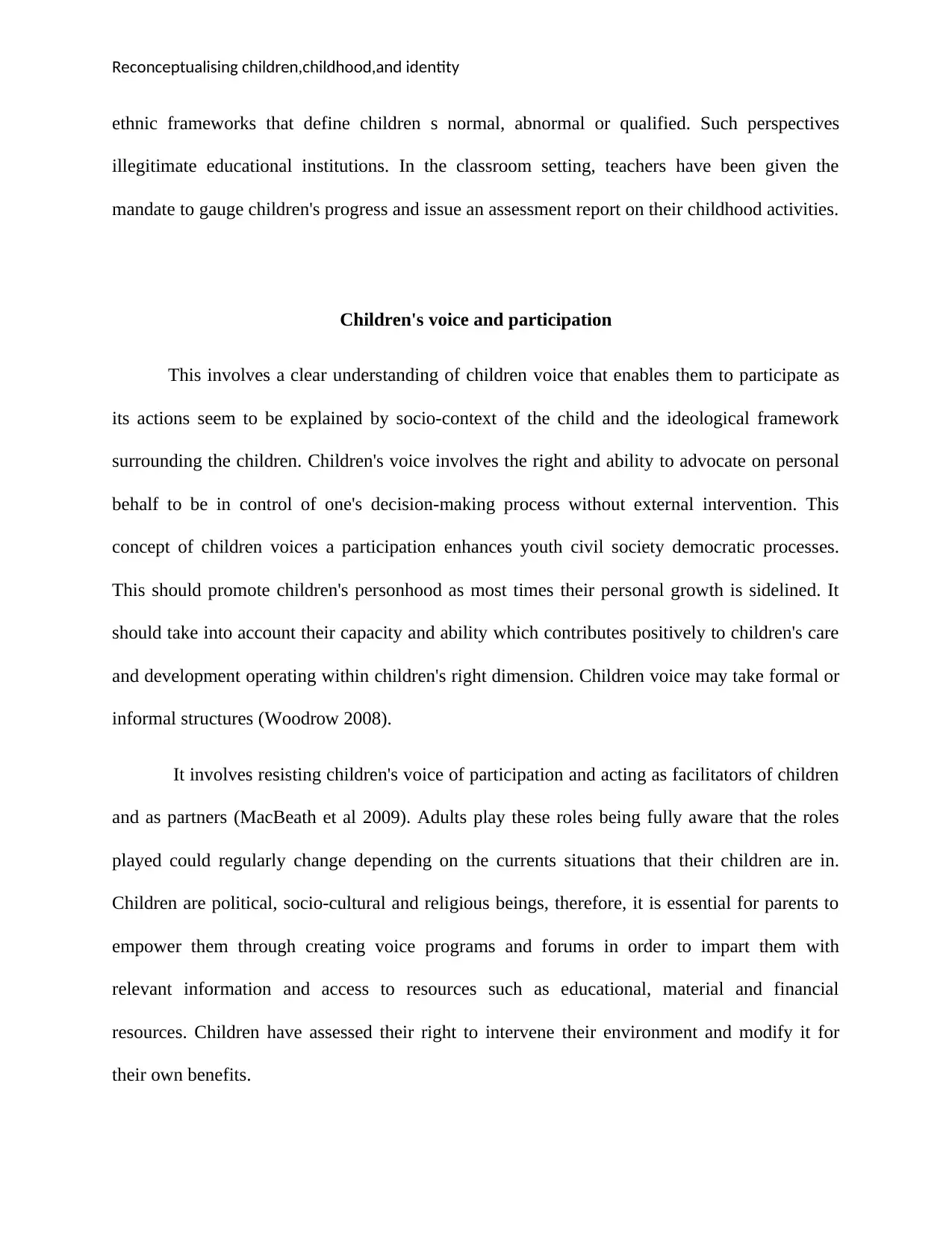
Reconceptualising children,childhood,and identity
ethnic frameworks that define children s normal, abnormal or qualified. Such perspectives
illegitimate educational institutions. In the classroom setting, teachers have been given the
mandate to gauge children's progress and issue an assessment report on their childhood activities.
Children's voice and participation
This involves a clear understanding of children voice that enables them to participate as
its actions seem to be explained by socio-context of the child and the ideological framework
surrounding the children. Children's voice involves the right and ability to advocate on personal
behalf to be in control of one's decision-making process without external intervention. This
concept of children voices a participation enhances youth civil society democratic processes.
This should promote children's personhood as most times their personal growth is sidelined. It
should take into account their capacity and ability which contributes positively to children's care
and development operating within children's right dimension. Children voice may take formal or
informal structures (Woodrow 2008).
It involves resisting children's voice of participation and acting as facilitators of children
and as partners (MacBeath et al 2009). Adults play these roles being fully aware that the roles
played could regularly change depending on the currents situations that their children are in.
Children are political, socio-cultural and religious beings, therefore, it is essential for parents to
empower them through creating voice programs and forums in order to impart them with
relevant information and access to resources such as educational, material and financial
resources. Children have assessed their right to intervene their environment and modify it for
their own benefits.
ethnic frameworks that define children s normal, abnormal or qualified. Such perspectives
illegitimate educational institutions. In the classroom setting, teachers have been given the
mandate to gauge children's progress and issue an assessment report on their childhood activities.
Children's voice and participation
This involves a clear understanding of children voice that enables them to participate as
its actions seem to be explained by socio-context of the child and the ideological framework
surrounding the children. Children's voice involves the right and ability to advocate on personal
behalf to be in control of one's decision-making process without external intervention. This
concept of children voices a participation enhances youth civil society democratic processes.
This should promote children's personhood as most times their personal growth is sidelined. It
should take into account their capacity and ability which contributes positively to children's care
and development operating within children's right dimension. Children voice may take formal or
informal structures (Woodrow 2008).
It involves resisting children's voice of participation and acting as facilitators of children
and as partners (MacBeath et al 2009). Adults play these roles being fully aware that the roles
played could regularly change depending on the currents situations that their children are in.
Children are political, socio-cultural and religious beings, therefore, it is essential for parents to
empower them through creating voice programs and forums in order to impart them with
relevant information and access to resources such as educational, material and financial
resources. Children have assessed their right to intervene their environment and modify it for
their own benefits.

Reconceptualising children,childhood,and identity
Children agency
It is evident that India is comprised of more orphans in the world than other nations.
SICW has placed approximately 2500 children in living homes across the nation making
sponsors loving in Kolkata to visits the beneficiaries. Society for children welfare in India
involves a non-profit organization serving to improve child care and development. The
government of India has various children agencies (Mitchell & Haynes 2009). For example, the
central adoption resource agency (CARA has a visionary mission to support children for their
betterment. Children's voice and agency focus on key areas of children empowerment for
example freedom for maltreatment, sexual and health rights, housing and caring through the
providence of education facilities. It amplifies the voices of the children in education, gender
equality and protection from child abuse
Children curriculum and pedagogy
The term pedagogy involves the available holistic nature of early childhood profession in
the education sector especially through prospers of character building and upholding social
relationships. It involves curriculum decision-making practices, teaching, and learning which
imparts important information and skills to children. The curriculum is the subject content taught
at school while pedagogy is the art of science of teaching techniques that are utilized to teach
children.
The right start curriculum was designed in various countries to impart levels of
understanding so that children who have the distinct knowledge and learning ability rates can get
new information from each activity. It engages cognitive ability from social and physical
Children agency
It is evident that India is comprised of more orphans in the world than other nations.
SICW has placed approximately 2500 children in living homes across the nation making
sponsors loving in Kolkata to visits the beneficiaries. Society for children welfare in India
involves a non-profit organization serving to improve child care and development. The
government of India has various children agencies (Mitchell & Haynes 2009). For example, the
central adoption resource agency (CARA has a visionary mission to support children for their
betterment. Children's voice and agency focus on key areas of children empowerment for
example freedom for maltreatment, sexual and health rights, housing and caring through the
providence of education facilities. It amplifies the voices of the children in education, gender
equality and protection from child abuse
Children curriculum and pedagogy
The term pedagogy involves the available holistic nature of early childhood profession in
the education sector especially through prospers of character building and upholding social
relationships. It involves curriculum decision-making practices, teaching, and learning which
imparts important information and skills to children. The curriculum is the subject content taught
at school while pedagogy is the art of science of teaching techniques that are utilized to teach
children.
The right start curriculum was designed in various countries to impart levels of
understanding so that children who have the distinct knowledge and learning ability rates can get
new information from each activity. It engages cognitive ability from social and physical
Secure Best Marks with AI Grader
Need help grading? Try our AI Grader for instant feedback on your assignments.
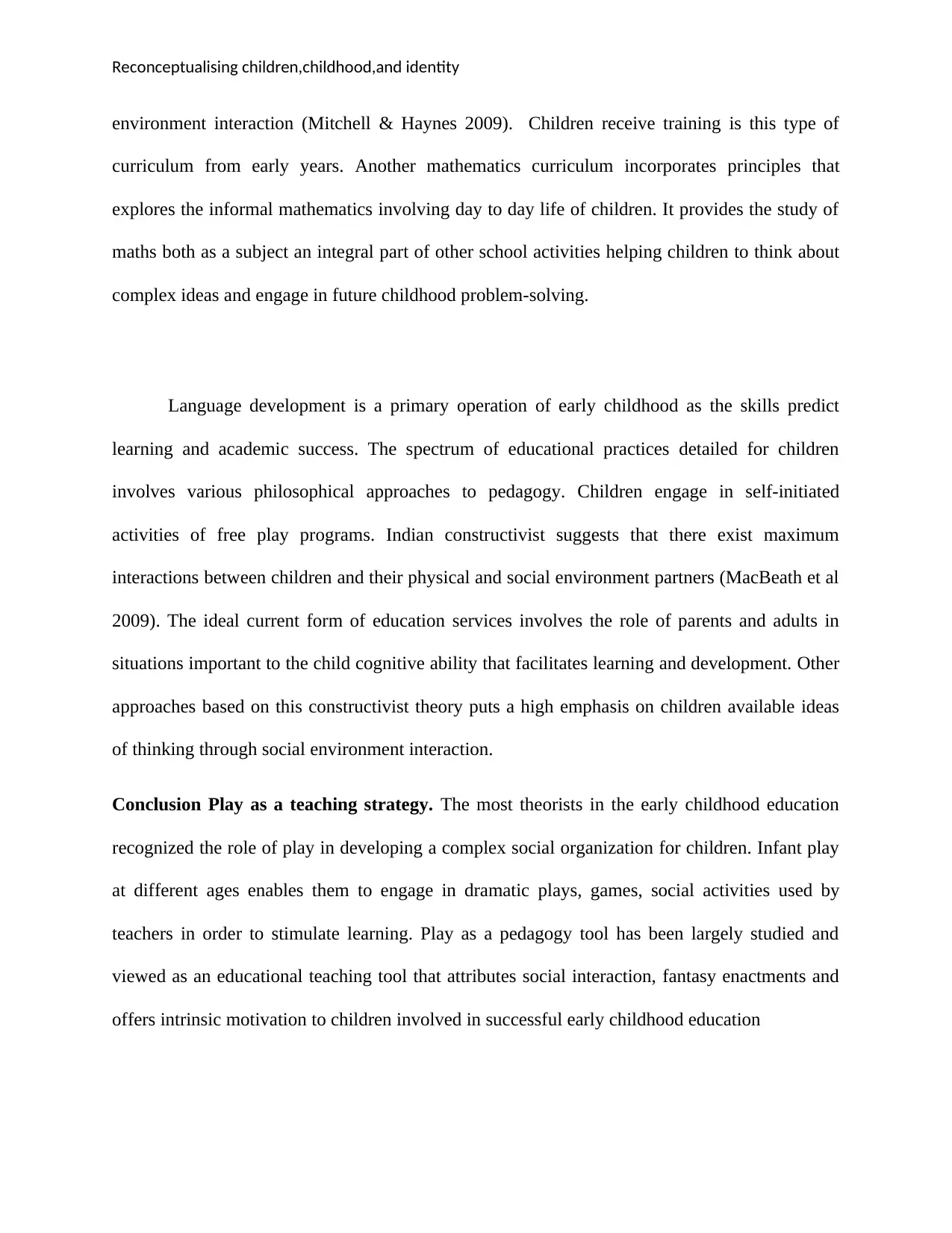
Reconceptualising children,childhood,and identity
environment interaction (Mitchell & Haynes 2009). Children receive training is this type of
curriculum from early years. Another mathematics curriculum incorporates principles that
explores the informal mathematics involving day to day life of children. It provides the study of
maths both as a subject an integral part of other school activities helping children to think about
complex ideas and engage in future childhood problem-solving.
Language development is a primary operation of early childhood as the skills predict
learning and academic success. The spectrum of educational practices detailed for children
involves various philosophical approaches to pedagogy. Children engage in self-initiated
activities of free play programs. Indian constructivist suggests that there exist maximum
interactions between children and their physical and social environment partners (MacBeath et al
2009). The ideal current form of education services involves the role of parents and adults in
situations important to the child cognitive ability that facilitates learning and development. Other
approaches based on this constructivist theory puts a high emphasis on children available ideas
of thinking through social environment interaction.
Conclusion Play as a teaching strategy. The most theorists in the early childhood education
recognized the role of play in developing a complex social organization for children. Infant play
at different ages enables them to engage in dramatic plays, games, social activities used by
teachers in order to stimulate learning. Play as a pedagogy tool has been largely studied and
viewed as an educational teaching tool that attributes social interaction, fantasy enactments and
offers intrinsic motivation to children involved in successful early childhood education
environment interaction (Mitchell & Haynes 2009). Children receive training is this type of
curriculum from early years. Another mathematics curriculum incorporates principles that
explores the informal mathematics involving day to day life of children. It provides the study of
maths both as a subject an integral part of other school activities helping children to think about
complex ideas and engage in future childhood problem-solving.
Language development is a primary operation of early childhood as the skills predict
learning and academic success. The spectrum of educational practices detailed for children
involves various philosophical approaches to pedagogy. Children engage in self-initiated
activities of free play programs. Indian constructivist suggests that there exist maximum
interactions between children and their physical and social environment partners (MacBeath et al
2009). The ideal current form of education services involves the role of parents and adults in
situations important to the child cognitive ability that facilitates learning and development. Other
approaches based on this constructivist theory puts a high emphasis on children available ideas
of thinking through social environment interaction.
Conclusion Play as a teaching strategy. The most theorists in the early childhood education
recognized the role of play in developing a complex social organization for children. Infant play
at different ages enables them to engage in dramatic plays, games, social activities used by
teachers in order to stimulate learning. Play as a pedagogy tool has been largely studied and
viewed as an educational teaching tool that attributes social interaction, fantasy enactments and
offers intrinsic motivation to children involved in successful early childhood education
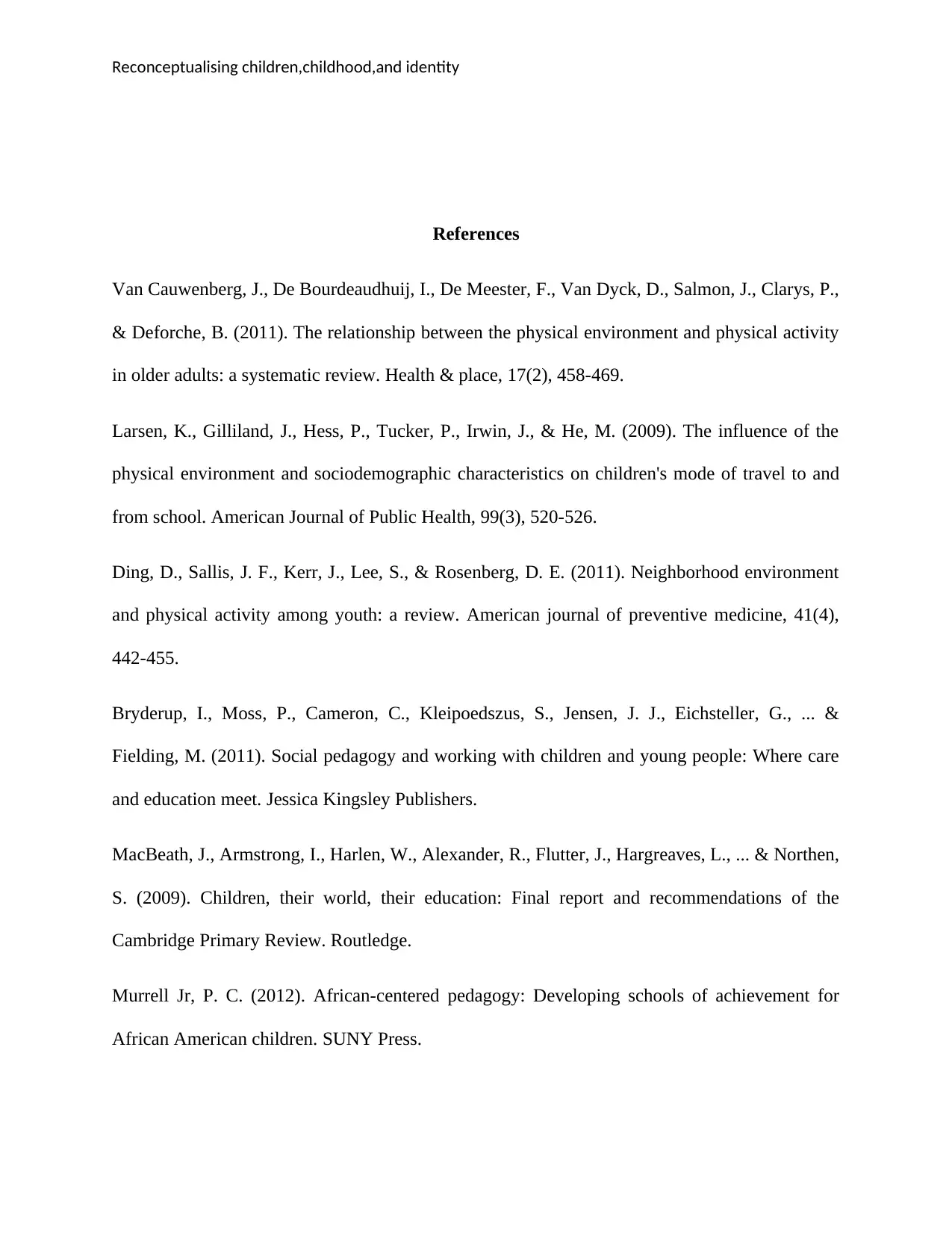
Reconceptualising children,childhood,and identity
References
Van Cauwenberg, J., De Bourdeaudhuij, I., De Meester, F., Van Dyck, D., Salmon, J., Clarys, P.,
& Deforche, B. (2011). The relationship between the physical environment and physical activity
in older adults: a systematic review. Health & place, 17(2), 458-469.
Larsen, K., Gilliland, J., Hess, P., Tucker, P., Irwin, J., & He, M. (2009). The influence of the
physical environment and sociodemographic characteristics on children's mode of travel to and
from school. American Journal of Public Health, 99(3), 520-526.
Ding, D., Sallis, J. F., Kerr, J., Lee, S., & Rosenberg, D. E. (2011). Neighborhood environment
and physical activity among youth: a review. American journal of preventive medicine, 41(4),
442-455.
Bryderup, I., Moss, P., Cameron, C., Kleipoedszus, S., Jensen, J. J., Eichsteller, G., ... &
Fielding, M. (2011). Social pedagogy and working with children and young people: Where care
and education meet. Jessica Kingsley Publishers.
MacBeath, J., Armstrong, I., Harlen, W., Alexander, R., Flutter, J., Hargreaves, L., ... & Northen,
S. (2009). Children, their world, their education: Final report and recommendations of the
Cambridge Primary Review. Routledge.
Murrell Jr, P. C. (2012). African-centered pedagogy: Developing schools of achievement for
African American children. SUNY Press.
References
Van Cauwenberg, J., De Bourdeaudhuij, I., De Meester, F., Van Dyck, D., Salmon, J., Clarys, P.,
& Deforche, B. (2011). The relationship between the physical environment and physical activity
in older adults: a systematic review. Health & place, 17(2), 458-469.
Larsen, K., Gilliland, J., Hess, P., Tucker, P., Irwin, J., & He, M. (2009). The influence of the
physical environment and sociodemographic characteristics on children's mode of travel to and
from school. American Journal of Public Health, 99(3), 520-526.
Ding, D., Sallis, J. F., Kerr, J., Lee, S., & Rosenberg, D. E. (2011). Neighborhood environment
and physical activity among youth: a review. American journal of preventive medicine, 41(4),
442-455.
Bryderup, I., Moss, P., Cameron, C., Kleipoedszus, S., Jensen, J. J., Eichsteller, G., ... &
Fielding, M. (2011). Social pedagogy and working with children and young people: Where care
and education meet. Jessica Kingsley Publishers.
MacBeath, J., Armstrong, I., Harlen, W., Alexander, R., Flutter, J., Hargreaves, L., ... & Northen,
S. (2009). Children, their world, their education: Final report and recommendations of the
Cambridge Primary Review. Routledge.
Murrell Jr, P. C. (2012). African-centered pedagogy: Developing schools of achievement for
African American children. SUNY Press.

Reconceptualising children,childhood,and identity
Nolan, J., & McBride, M. (2014). Beyond gamification: reconceptualizing game-based learning
in early childhood environments. Information, Communication & Society, 17(5), 594-608.
Ní Laoire, C., Carpena-Méndez, F., Tyrrell, N., & White, A. (2010). Introduction: Childhood and
migration—mobilities, homes, and belongings. Childhood, 17(2), 155-162.
Esser, F., Baader, M. S., Betz, T., & Hungerland, B. (Eds.). (2016). Reconceptualising agency
and childhood: New perspectives in childhood studies. Routledge.
Woodrow, C. (2008). Discourses of professional identity in early childhood: Movements in
Australia. European Early Childhood Education Research Journal, 16(2), 269-280.
Lukose, R. A. (2009). Liberalization's children: Gender, youth, and consumer citizenship in
globalizing India. Duke University Press.
Perreira, K. M., & Ornelas, I. J. (2011). The physical and psychological well-being of immigrant
children. The Future of Children, 21(1), 195-218.
Coleman, M. C. (2008). American Indian children at school, 1850-1930. Univ. Press of
Mississippi. Graglia, L. A. (2009). Birthright citizenship for children of illegal aliens: An
irrational public policy. Tex. Rev. L. & Pol., 14, 1.
Hollingworth, S., Mansaray, A., Allen, K., & Rose, A. (2011). Parents' perspectives on
technology and children's learning in the home: social class and the role of the habitus. Journal of
Computer Assisted Learning, 27(4), 347-360.
Mitra, D. L. (2009). Strengthening student voice initiatives in high schools: An examination of
the supports needed for school-based youth-adult partnerships. Youth & Society, 40(3), 311-335.
Nolan, J., & McBride, M. (2014). Beyond gamification: reconceptualizing game-based learning
in early childhood environments. Information, Communication & Society, 17(5), 594-608.
Ní Laoire, C., Carpena-Méndez, F., Tyrrell, N., & White, A. (2010). Introduction: Childhood and
migration—mobilities, homes, and belongings. Childhood, 17(2), 155-162.
Esser, F., Baader, M. S., Betz, T., & Hungerland, B. (Eds.). (2016). Reconceptualising agency
and childhood: New perspectives in childhood studies. Routledge.
Woodrow, C. (2008). Discourses of professional identity in early childhood: Movements in
Australia. European Early Childhood Education Research Journal, 16(2), 269-280.
Lukose, R. A. (2009). Liberalization's children: Gender, youth, and consumer citizenship in
globalizing India. Duke University Press.
Perreira, K. M., & Ornelas, I. J. (2011). The physical and psychological well-being of immigrant
children. The Future of Children, 21(1), 195-218.
Coleman, M. C. (2008). American Indian children at school, 1850-1930. Univ. Press of
Mississippi. Graglia, L. A. (2009). Birthright citizenship for children of illegal aliens: An
irrational public policy. Tex. Rev. L. & Pol., 14, 1.
Hollingworth, S., Mansaray, A., Allen, K., & Rose, A. (2011). Parents' perspectives on
technology and children's learning in the home: social class and the role of the habitus. Journal of
Computer Assisted Learning, 27(4), 347-360.
Mitra, D. L. (2009). Strengthening student voice initiatives in high schools: An examination of
the supports needed for school-based youth-adult partnerships. Youth & Society, 40(3), 311-335.
Paraphrase This Document
Need a fresh take? Get an instant paraphrase of this document with our AI Paraphraser
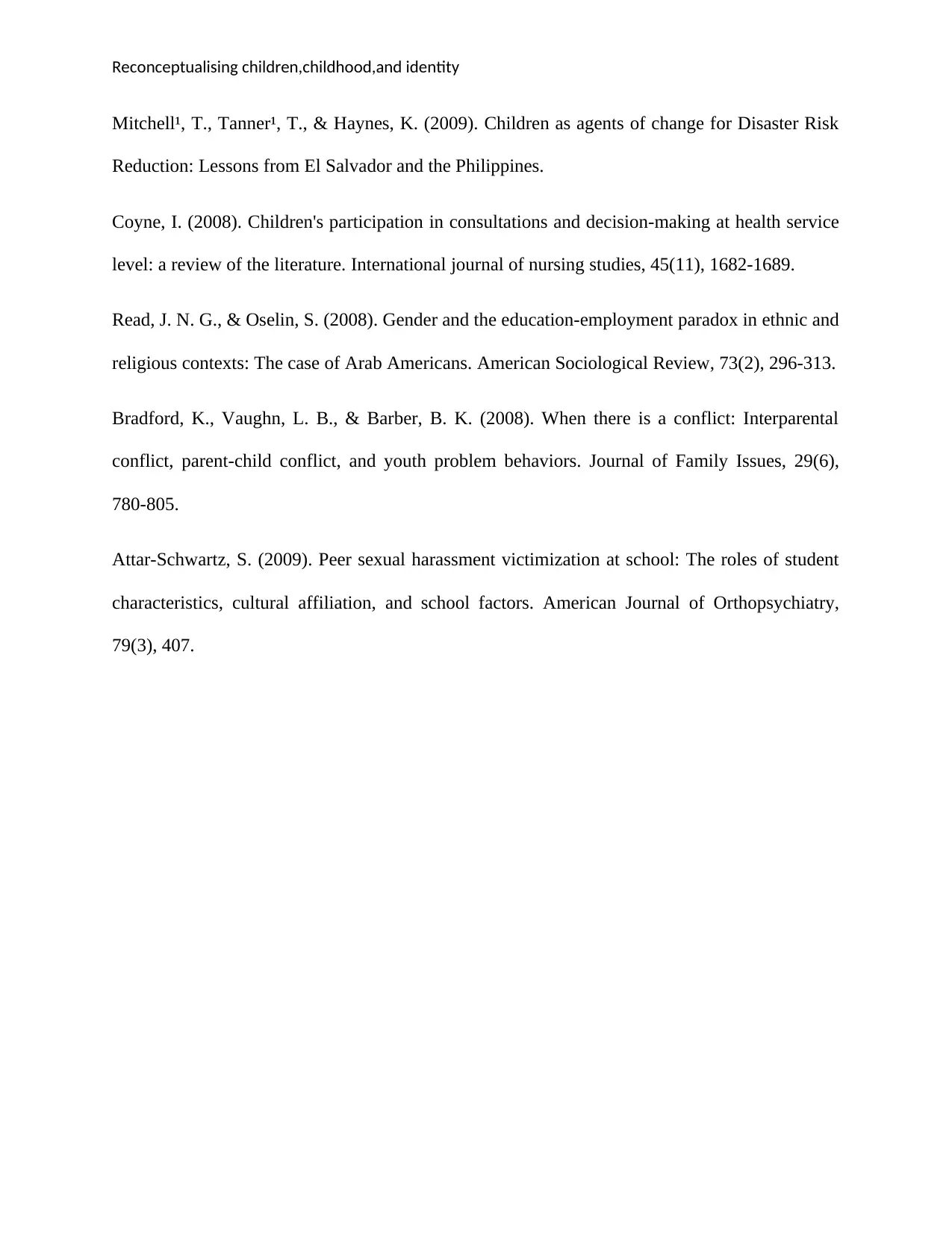
Reconceptualising children,childhood,and identity
Mitchell¹, T., Tanner¹, T., & Haynes, K. (2009). Children as agents of change for Disaster Risk
Reduction: Lessons from El Salvador and the Philippines.
Coyne, I. (2008). Children's participation in consultations and decision-making at health service
level: a review of the literature. International journal of nursing studies, 45(11), 1682-1689.
Read, J. N. G., & Oselin, S. (2008). Gender and the education-employment paradox in ethnic and
religious contexts: The case of Arab Americans. American Sociological Review, 73(2), 296-313.
Bradford, K., Vaughn, L. B., & Barber, B. K. (2008). When there is a conflict: Interparental
conflict, parent-child conflict, and youth problem behaviors. Journal of Family Issues, 29(6),
780-805.
Attar-Schwartz, S. (2009). Peer sexual harassment victimization at school: The roles of student
characteristics, cultural affiliation, and school factors. American Journal of Orthopsychiatry,
79(3), 407.
Mitchell¹, T., Tanner¹, T., & Haynes, K. (2009). Children as agents of change for Disaster Risk
Reduction: Lessons from El Salvador and the Philippines.
Coyne, I. (2008). Children's participation in consultations and decision-making at health service
level: a review of the literature. International journal of nursing studies, 45(11), 1682-1689.
Read, J. N. G., & Oselin, S. (2008). Gender and the education-employment paradox in ethnic and
religious contexts: The case of Arab Americans. American Sociological Review, 73(2), 296-313.
Bradford, K., Vaughn, L. B., & Barber, B. K. (2008). When there is a conflict: Interparental
conflict, parent-child conflict, and youth problem behaviors. Journal of Family Issues, 29(6),
780-805.
Attar-Schwartz, S. (2009). Peer sexual harassment victimization at school: The roles of student
characteristics, cultural affiliation, and school factors. American Journal of Orthopsychiatry,
79(3), 407.
1 out of 14
Related Documents
Your All-in-One AI-Powered Toolkit for Academic Success.
+13062052269
info@desklib.com
Available 24*7 on WhatsApp / Email
![[object Object]](/_next/static/media/star-bottom.7253800d.svg)
Unlock your academic potential
© 2024 | Zucol Services PVT LTD | All rights reserved.





